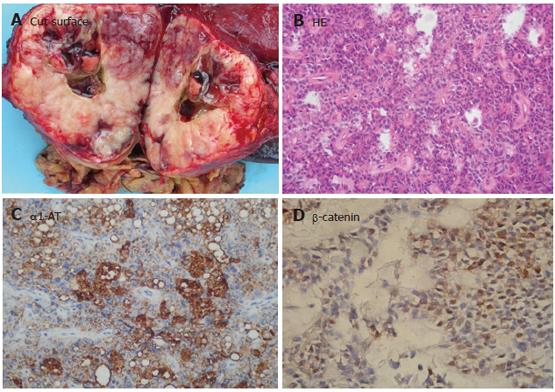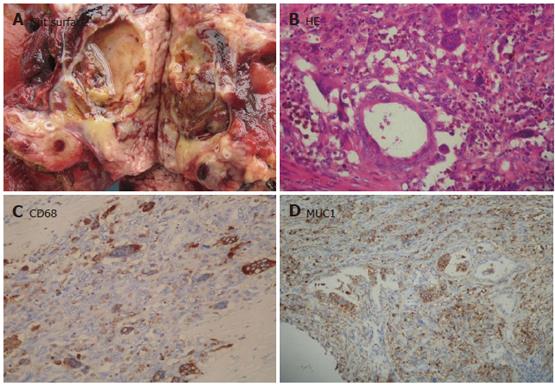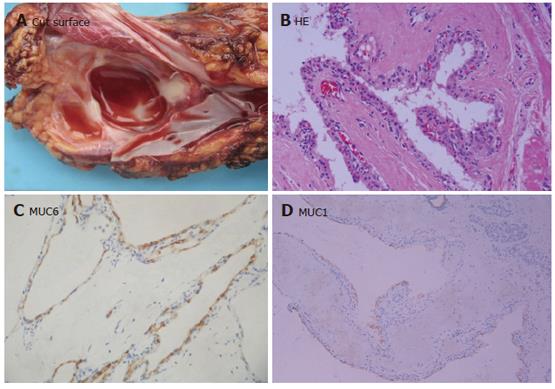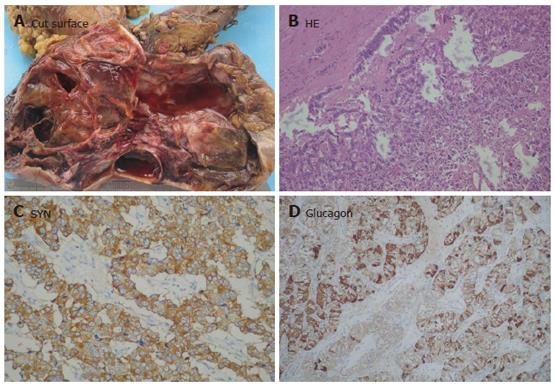Copyright
©2006 Baishideng Publishing Group Co.
World J Gastroenterol. Dec 7, 2006; 12(45): 7380-7387
Published online Dec 7, 2006. doi: 10.3748/wjg.v12.i45.7380
Published online Dec 7, 2006. doi: 10.3748/wjg.v12.i45.7380
Figure 4 Solid pseudo-papillary neoplasia.
A: Cystic structures containing hemorrhagic debris surrounded by hemorrhagic-necrotic tissue; B: SPN showing solid areas consisting of monotonous polygonal epithelioid cells, often with minimal intervening stroma accompanied with innumerable capillary-sized vessels. In the pseudopapillary regions, the cells away from the small vessels appeared to have dropped away, leaving an irregular cuff of cells surrounding each vascular core (HE × 100); C: SPN showing a consistent pattern of reactivity for α-1-AT (Envison × 100); D: Positive β-catenin and progesteron receptor limited to the nuclei of tumor cells (Envison × 200).
Figure 5 Cystic ductal adenocarcinoma.
A: Part of the tumor showing cystic wall with brown color; B: Cystic wall consisting of multinuclear giant cells (HE × 100); C: Giant tumor cells positive for CD68 (Envison × 100); D: Diffusely stained MUC1 in neoplastic cells, including duct and giant tumor cells (Envison × 100).
Figure 1 Intraductal papillary mucinous neoplasia.
A: Sectioning of the pancreas revealing papillary tumors (arrow) with sticky mucin in dilated main panceatic ducts; B: Epithelial proliferative lesions that involve the main or secondary pancreatic duct showing a papillary architecture (HE × 40); C: MUC2 diffuse expression in papillary epithelial cells of intestinal type (Envison × 40); D: Focally stained MUC5AC in cytoplasm of gastric subtype tumor cells (Envison × 100).
Figure 2 Serous cystic neoplasm.
A: Smooth and thin cyst wall on cut surface containing clear red-brown fulid; B: Cysts wall lined by a single layer of cuboidal or flattened epithelial cells with pale to clear cytoplasm, and centrally located tumor cells with round to oval nuclei (HE × 100); C: Tumor cells strongly positive for MUC6 (Envison × 100); D: MUC1 expression in some tumor cells (Envison × 40).
Figure 3 Mucinous cystic neoplasm.
A: Tumors presented as large round cystic masses with a unilocular cut surface; B: Cysts lined by mucin-producing epithelial cells with variant degrees of dysplasia supported by an ovarian-like stroma; C: MUC5AC expression in cytoplasm; D: Faint MUC6 expression in apical tumor cells (Envison × 100).
Figure 6 Cystic pancreatic endocrine tumor.
A: Cut surface of a large PET showing degeneration and cystic change; B: Tumor cells arranged as trabecular nests in the remnant area (HE × 100); C: SYN presented in all tumor cells (Envison × 200); D: Most tumor cells expressing glucagon in cytoplasm (Envison × 100).
- Citation: Ji Y, Lou WH, Jin DY, Kuang TT, Zeng MS, Tan YS, Zeng HY, Sujie A, Zhu XZ. A series of 64 cases of pancreatic cystic neoplasia from an institutional study of China. World J Gastroenterol 2006; 12(45): 7380-7387
- URL: https://www.wjgnet.com/1007-9327/full/v12/i45/7380.htm
- DOI: https://dx.doi.org/10.3748/wjg.v12.i45.7380














